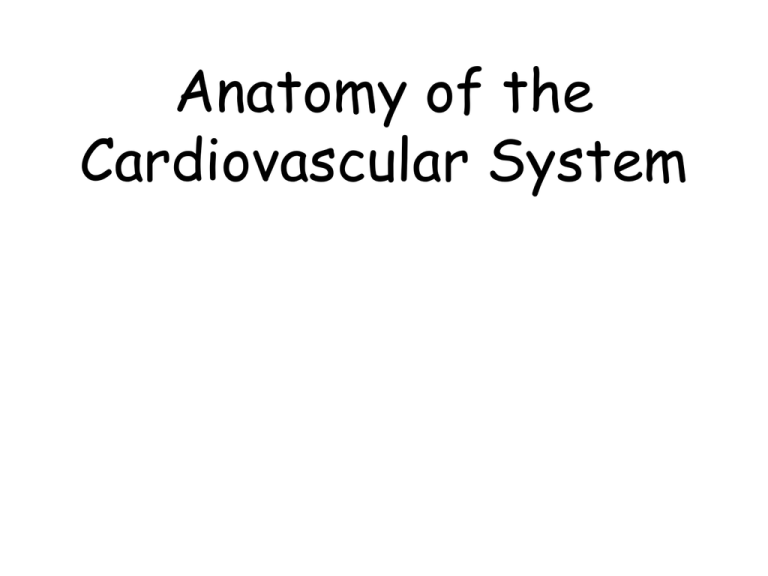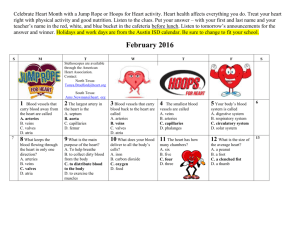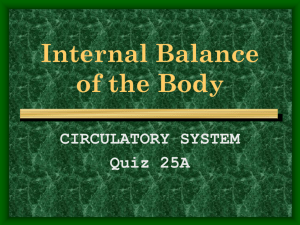Anatomy of the Cardiovascular System
advertisement

Anatomy of the Cardiovascular System Cardiovascular System • Also circulatory system • Consists of: the heart, arteries, veins, capillaries Heart • Four chamber muscular organ • Comparable to the size of a closed fist • Located in the mediastinum – Behind sternum – Between 2nd and 6th ribs – Between T5-T8 • Apex – base of heart – Located at the 5th intercostal space Heart Coverings of the Heart • Pericardium – loose fitting sac surrounding the heart – Fibrous pericardium – tough, loose-fitting, inelastic – Serous pericardium • Parietal layer: lines the inside of the fibrous pericardium • Visceral layer: adheres to outside of the heart – Pericardial space: between parietal and visceral layer • Filled with 10-15mL of pericardial fluid • Decreases friction Walls of the Heart • Epicardium – outer layer – Epicardium = serous pericardium • Myocardium – thick, contractile layer composed of cardiac muscle cells – Intercalated disks contain many gap junctions – Allow cardiac muscle cells to function as a single unit syncytium • Endocaridium – interior of cardiac wall – Endothelial tissue – Covers projections of myocardial tissue called trabeculae Walls of the Heart Chambers of the Heart • Atria – two superior chambers – “Receiving chambers” – Blood from veins enters atria • Ventricles – two inferior chambers – “pumping chambers” – Thick muscular walls to increase force of pumping action • Left > right – Separated by interventricular septum Valves of the Heart • Permit blood flow in one direction during circulation • Atrioventricular valves (AV valves) – Also cuspid valves – Between atria and ventricles • Semilunar (SL valves) – Between R ventricle and pulmonary arteries and L ventricle and aorta Atrioventricular Valves • Tricuspid valve – Btwn R atrium and ventricle – 3 flaps of endocardium – Connected to ventricular papillary muscle via chordae tendinae • Bicuspid valve – Btwn L atrium and ventricle – Also called mitral valve – Two flaps of endocardium Semilunar Valves • Pulmonary semilunar valve – Btwn R ventricle and pulmonary trunk • Aorta semilunar valve – Btwn L ventricle and aorta Chambers & Valves Trace the blood flow through the heart Blood Supply to the Heart • Right and left coronary arteries – First branches off aorta – Right coronary artery right marginal artery & posterior interventricular artery – Left coronary artery circumflex artery & anterior interventricular artery – Most of the blood goes to the L ventricle – In 50% of the population, the R coronary artery is dominant Blood Supply to the Heart • Anastomosis: Connections between blood vessels that allow for collateral circulation • Few exist between large branches of coronary arteries • In presence of an obstruction in a large artery ischemia will result to a large area of tissue – Myocardial infarction (MI) (aka heart attack) • Anastomoses do exists between smaller branches of the R and L coronary arteries Blood Supply to the Heart • After traveling through the capillaries of the heart, blood empties into the R atrium via the coronary sinus Conduction System of the Heart • Four structures composed of modified cardiac muscle • Sinoatrial Node (SA Node) – Pacemaker of the heart – 100s of cells in the R atrium near the opening of the superior vena cava • Atrioventricular Node (AV Node) – Small mass of cardiac muscle tissue – Left lower border of R atrium Conduction System of the Heart • Atrioventricular Bundle – Also Bundle of His – Bundle of specialized cardiac muscle fibers originating in the AV node – Branches into R and L branches eventually becoming Purkinje fibers – Extend into the walls of the ventricles and papillary muscles Types of Blood Vessels • Artery – carries oxygenated blood away from the heart – “distributors” – Arteriole: small artery – Precapillary sphincters: regulate the blood flow into capillaries Types of Blood Vessels • Vein – carries unoxygenated blood towards the heart – Great ability to stretch (capacitance) – Function as reservoirs: blood pools in the valves then is pushed forward from the pumping pressure – Venules: small vein Types of Blood Vessels Types of Blood Vessels • Capillaries – arterial system switches to venous system – “primary exchange vessels” – Transport materials to and from the cells – Speed of blood flow decreases to increase contact time – Microcirculation: blood flow between arterioles, capillaries and venules Types of Blood Vessels Structure of Blood Vessels • Tunica adventitia - outermost layer – Fibrous connective tissue – Holds vessels open; prevents tearing of vessels walls during body movements – Larger in veins than arteries • Tunica media – middle layer – Smooth muscle and elastic CT – Helps vessels constrict and dilate – Larger in arteries Structure of Blood Vessels • Tunica intima – innermost layer – Composed of endothelium – Semilunar valves present in veins – One cell thick in capillaries Circulatory Routes • Systemic Circulation – blood flow from the L ventricle to the body & back to the R atrium • Pulmonary Circulation – blood flow from the R ventricle to the lungs and back to the L atrium Circulatory Routes Aorta Systemic Arteries • • • • • • • • Arch of aorta Subclavian (L and R) Brachiocephalic common carotid (L and R) Axillary (L and R) Brachial (L and R) Radial Ulnar • • • • • • • • Abdominal aorta Common iliac External iliac Femoral Popliteal Posterior tibial Anterior tibial Dorsal pedis Systemic Veins • • • • • Superior vena cava Inferior vena cava External jugular Internal jugular Brachiocephalic (L and R) • Subclavian (L and R) • Cephalic • axillary • • • • • • • • • Basilic Median basilic Median cubital Common iliac External iliac Femoral Popliteal Great saphenous Small saphenous Fetal Circulation • Two umbilical arteries carry blood to the placenta • The placenta allows for exchange of oxygen and nutrients from the mother. Maternal and fetal blood do NOT mix. • Umbilical vein returns oxygenated blood and enters fetus via the umbilicus • Foramen ovale – hole btwn the R and L atria – Allows for blood to bypass the R ventricle and pulmonary circulation Fetal Circulation • Ductus arteriosus – small vessel connecting the pulmonary artery and the aorta – Allows for another bypass route from the lungs **Most of fetal blood is a mixture of oxygenated and deoxygenated blood** Fetal Circulation Changes After Birth • Umbilical vein become round ligament • Umbilical arteries become umbilical ligaments • Foramen ovale closes after first few breaths – Full closure may take up to 9 months • Ductus arteriosus contracts as soon as respirations begin – Become fibrous cord Changes After Birth Pericardium Disorders • Pericarditis – inflammation of the heart – Causes: trauma, viral or bacteria infection, tumor – Edema causes visceral and parietal layers to rub together = chest pain – Pus or blood build up in pericardial space – S/S • Pain with respirations or coughing, dyspnea, restlessness – Complications: Pericardial Effusion, Cardiac Tamponade – Treatment: • Antibiotics, pain meds, antiinflammatory meds, pericardiocentesis (Cardiac Tamponade) Cardiac Tamponade Heart Valve Disorders • General Principles: – Congenital defect: decreased pumping efficiency – Incompetent valve leak: allows backflow into previous chamber – Stenosed valves: narrowed valve; slowing blood from out of chamber Heart Valve Disorders • Mitral Valve Prolapse (MVP) – Flaps of mitral valve extend back into L atrium causes leaking – Mostly genetic basis – 1 in 20 people – S/S: most asymptomatic; chest pain, fatigue – Treatment: valvuloplasty Mitral Valve Prolapse Heart Valve Disorders • Aortic Regurgitation – Blood leaks back into L ventricle during ejection into the aorta – Volume overload in L ventricle, hypertrophy, dilation of L ventricle – Complications: myocaridal ischemia – Treatment: valvuloplasty Myocardium Disorders • Atherosclerosis – Type of arteriosclerosis – Lipids build up on the inside of vessel walls calcify vessels hard & brittle – Risk factors: cigarette smoking, high fat/cholesterol diet, hypertension Atherosclerosis Myocardium Disorders • Myocardial Infarction – – – – “Heart Attack” Coronary thrombosis: clot Coronary embolism: mobilized clot Occlude coronary artery heart tissue deprived of oxygen cell death – S/S: • Angina pectoris – severe chest pain resulting from inadequate oxygen to myocardium – Treatment: Coronary Bypass Surgery • Veins are harvested from other areas of the body and used to bypass obstructions Myocardium Disorders • Congestive Heart Failure (CHF) – “Left-sided Heart Failure” – Inability of the L ventricle to pump blood efficiently – Causes: myocardial infarction – S/S: decreased pumping pressure in systemic circulation; retained fluids • Can lead to congestion in pulmonary circulation pulmonary edema right-sided heart failure – Treatment: heart transplant Congestive Heart Failure Myocardium Disorders • Coronary Artery Disease (CAD) – Leading cause of death in US – General term to describe decreased blood flow to myocardium & associated side effects Disorders of the Arteries • Arteriosclerosis – Arteries become occluded, weak and hardened – Complications: ischemia, necrosis, gangrene – Risk factors: age, diabetes, high fat/cholesterol diet, hypertension, smoking – Treatment: vasodilators, angioplasty, stent placement, bypass surgery – Complications: aneurysm Angioplasty Disorders of Veins • Varicose Veins – Enlarged veins caused by pooling – Results in varicosities or varices (“spider veins”) – Risk factors: standing for long periods • Semilunar valves widen more pooling – Treatment: compression stockings, surgical removal Varicose Veins Disorders of Veins • Phlebitis – vein inflammation – Causes: irritation by IV catheter • Thrombophlebitis – Deep vein thrombosis (DVT) – Phlebitis caused by a clot – S/S • Pain, redness, swelling – Complications • Pulmonary embolism DVT Pulmonary Embolism Venous Stasis Ulcers • Result of chronic vein insufficiency • Lack of oxygen to peripheral tissues • Elevate leg & apply pressure • Irregular edges • “Aching” pain Patent Ductus Arteriosus (PDA) Atrial Septal Defect (ASD) Ventricular Septal Defect (VSD) Tetralogy of Fallot (TOF)



